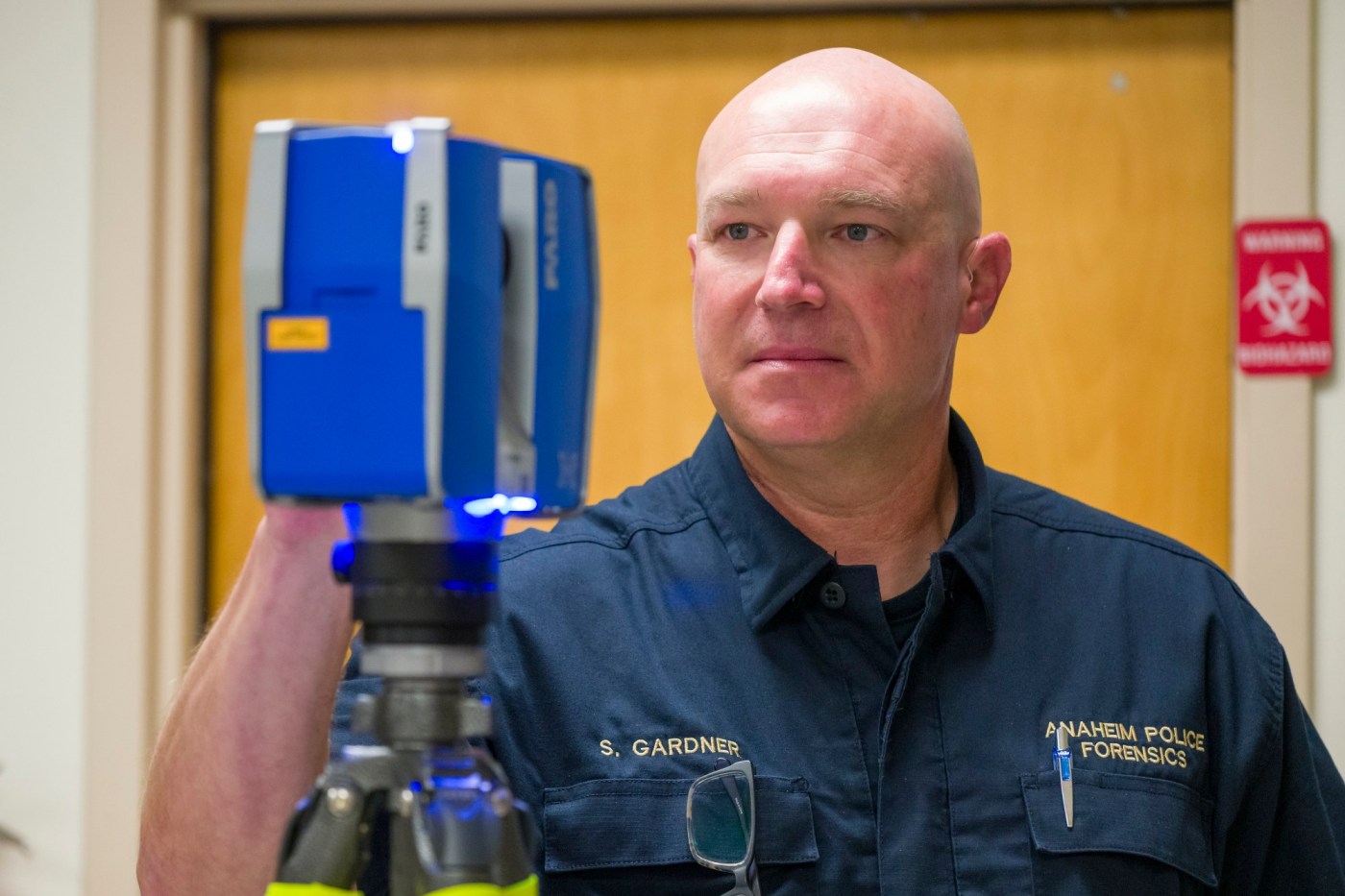Crime-scene models with detailed measurements once took hours to collect.
Now, law-enforcement agencies are increasingly turning to new technology to help speed up the work and better collect evidence: laser scanner technology, long a mainstay of construction and surveying work.
The technology is rapidly replacing the old days of crime-scene investigators crafting hand sketches and using tape measures to laboriously take down measurements.
It centers around a device that looks, at first glance, like a camera, which is its — but it can create 3D-like images. It’s roughly as big as a shoebox and sits atop a tripod and holds a spinning mirror and a laser.
The device rotates 360 degrees, also scanning vertically. It first snaps hundreds of thousands of measurements, crafting a 3D model of the scene.
Then, it takes a stream of color photographs.
“In the old days, you would just use a tape measure,” said Steve Gardner, a forensic services supervisor with the Anaheim Police Department. “Now, you have hundreds of thousands of measurements.”
Once crime scene techs are back at the station, the scanned data is stitched together to create a model of the scene, allowing investigators and attorneys to jump between photographs and check on measurements between spaces.
Gardner compared it to 3D tours of homes featured on real estate sites such as Zillow, which allow visitors to virtually journey through a residence. Once the images from the device are stitched together, it allows users to look throughout the scene — up and down or to the sides — to jump between positions where the device was set up and to quickly determine distances and measurements.
New 3D cameras can go for more than $50,000. But many agencies are using older models.
For investigators working major accident scenes on public roadways, the ability to more quickly means streets and freeways get reopened quicker.
“We are very sensitive to closing roadways,” said Sgt. Mike Morrin, a team leader with the California Highway Patrol’s Border Division Multi-Disciplinary Accident Investigation Team. “We know it affects commerce, and people have things to do. What this tech does is enable us to process these scenes faster.”
CHP officials said the use of the technology can help cut down the processing time of a major accident scene, which can take hours, by a third or more.
“It is 2025, so we have to keep up with the times,” said Deputy Garrett Eggert, a member of the Orange County Sheriff Department’s Traffic Bureau. “Juries and insurance companies are expecting more, rather than a police report with a sketch diagram.”
For indoor crime scenes, such as murders, crime-scene techs must still work closely with detectives, as well as rely on their own experience and knowledge, to determine exactly where to place the scanners.
At times, the device picks up measurements or sees evidence that wasn’t noticed at the scene.
“You can never take too much evidence,” Morrin said. “When you are in doubt, take more evidence. You don’t know everything, and you may not know what you need.”
In major traffic accident investigations — where law enforcement officials are working to determine the pre-crash movement of a vehicle, the point of impact and where the vehicle went afterward — the laser scanner is at times used with a drone.
The scanner creates a rendering of the scene on the ground, the drone captures the larger map from above, and high-tech GPS systems tie it all to specific locations.
The new-tech evidence is melded into traditional evidence collected at collision scenes, for example — tire-friction marks, vehicle damage and data from in-vehicle computers — to tell the story of a crash.
“We have one chance to capture the incident scene as it is,” Morrin said. “It (the camera) allows us to capture those details with greater efficiency than traditional methods.”
Investigators say they have also used the technology to take 3D models of vehicles, rather than having to store them long-term.
“We have stuck it inside a car before; it just needs enough room to spin around in there,” Eggert said.
While it would have to be tightly planned out ahead of time, investigators say the technology could be potentially used to create virtual tours of crime scenes.
“We have never had a case where we had to do that,” Gardner said. “But the potential is there.”
Departments generally bring out the laser scanners for major collisions or higher-profile criminal investigations. Several years ago, various police agencies teamed up to take scans of an entire building that held a real estate office in Orange where three adults and a 9-year-old boy were shot dead in a planned attack that authorities believe was fueled by personal and business relationships.
Now, several years after the cameras began to be used by local law enforcement agencies, investigations in which the laser scanners were deployed have begun to make their way before juries.
During testimony earlier this year in the trial of Jeffrey Ferguson — a now-former Orange County Superior Court judge convicted of shooting and killing his wife in their Anaheim Hills home — an Anaheim Police Department forensic specialist gave jurors and court watchers a detailed lesson in what the technology can do.
Where evidence such as shell casings ended up and where Ferguson and his wife were sitting when the fatal gunshot were key.
“It is kind of what people expect these days with technology,” Eggert said. “Gone are the days of just giving them this 2D map. They are really looking for these 3D images.
“Being able to show this in court is really fascinating.”






